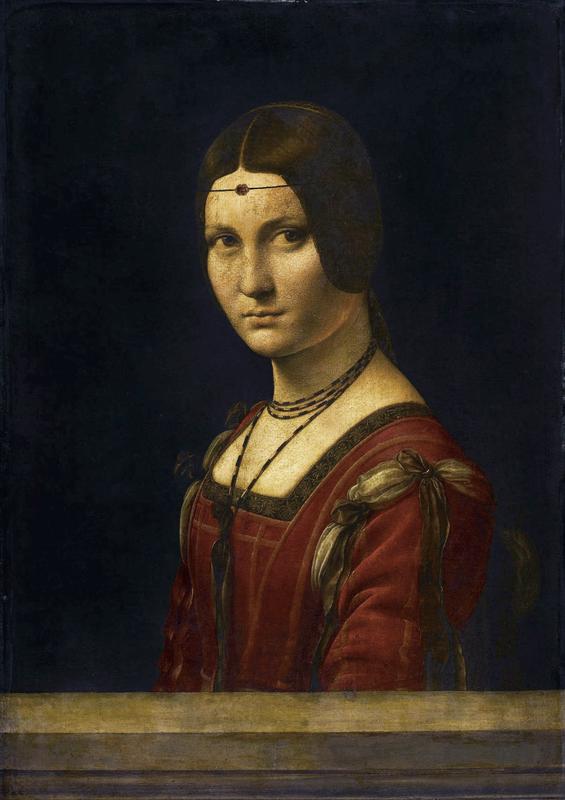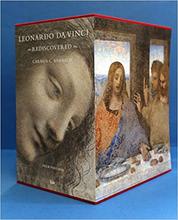More about Portrait of a Woman
- All
- Info
- Shop

Sr. Contributor
This painting's story has it all: Adultery, slander, and revenge syphilis.
The subject of the painting is wholly unknown. Plenty of names get tossed about, but everyone agrees that Leonardo painted it during his stay in Milan (more on that later). The most interesting prospect is that the painting depicts a woman married to a man named le Ferron. Mrs. le Ferron was giving it to King Francis I of France on the side. So, Le Ferron discovered the dalliance and did the most rational thing he could think of. He purposefully got the syph and passed it on to his wayward wife, who in turn gave it to the king. More likely candidates for the sitter include Isabella of Aragon, and either the wife or second mistress of Ludovico Sforza, duke of Milan. Considering the Milanese connection and Leonardo's history of helping Ludovico out in the mistress department, my bet's on one of those latter options.
La Belle was the subject of a huge trial in the 1920s. Andrée Hahn, the French wife of an American airman in WWI, tried to sell what she claimed was the authentic version of Leonardo's Ferronnière to the Kansas City Art Institute. Thus simultaneously proclaiming the version in the Louvre a mere copy. An influential English art dealer in New York named Joseph Duveen proclaimed the Hahn version bogus, and Andrée sued his fancy pants off (Joseph was a dandy, if nothing else). While Andrée was attempting to sell the painting for a whopping $250,000, she sued Duveen for slander. Asking for $500,000 in the trial over all the trouble he caused. Duveen's solution ultimately was to get the Hahn and Louvre Ferronnières side by side and bring in experts from the Met, Rijksmuseum, Imperial War Museum, and elsewhere. The experts decried Hahn's painting a copy at best. Burned.
For six years the case dragged on. A jury in New York, without any art expertise, ended the trial hung. Although nine of the twelve jurors favored the Hahns. Duveen ponied up $60,000 and legal fees to bury the debacle. The courtroom drama played out across newspapers around the world. People waited in line for hours to be in the trial's audience. Bootleg copies of the Louvre and Hahn versions of the work were on sale in department stores from sea to shining sea. Each version cheekily labeled as a copy, poking fun at the dilemma unfolding in New York courtrooms. Andrée's husband, Harry Hahn, wrote a book about the experience in 1946 titled The Rape of LaBelle emphasizing his belief that their painting was the legit La Belle. The Hahn Ferronnière sold in 2010 for $1.5 million, based off its infamy alone.
Featured Content
Here is what Wikipedia says about La Belle Ferronnière
La Belle Ferronnière (
French pronunciation: [la bɛl fɛʁɔnjɛʁ]) is a portrait of a lady, usually attributed to Leonardo da Vinci, in the Louvre. It is also known as Portrait of an Unknown Woman. The painting's title, applied as early as the seventeenth century, identifying the sitter as the wife or daughter of an ironmonger (a ferronnier), was said to be discreetly alluding to a reputed mistress of Francis I of France, married to a certain Le Ferron. Later she was identified as Lucretia Crivelli, a married lady-in-waiting to Duchess Beatrice of Milan, who became another of the Duke's mistresses.
Leonardo's Lady with an Ermine has also been known by this name. This was once believed to be a portrait of Cecilia Gallerani, one of the mistresses of Ludovico Sforza, Duke of Milan. The narrative and the title were applied to Lady with an Ermine when it was in Princess Izabela Czartoryska's collection, and became confused with La Belle Ferronnière by the presence of a ferronnière, a type of accessory worn across the forehead, in the painting as well.
Check out the full Wikipedia article about La Belle Ferronnière
















